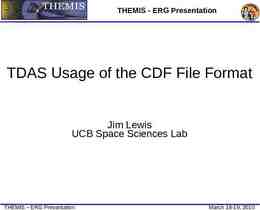Bridging The Gap – The Advanced Roadside Impaired Driving Enforcement
33 Slides427.50 KB
Bridging The Gap – The Advanced Roadside Impaired Driving Enforcement (A-RIDE) Program Chuck Hayes International Association of Chiefs of Police Impaired Driving Programs Regional Training Coordinator Washington Impaired Driver Traffic Safety Conference December 2007
A-RIDE Training Program Intended to “bridge the gap” between Standardized Field Sobriety Testing (SFST) and Drug Recognition Expert (DRE) Provides awareness to law enforcement personnel and other criminal justice professionals in the area of drug impairment in the context of traffic safety 2
Three Levels of Impaired Driving Training SFST – “The Foundation” A-RIDE – “Intermediate Level” DRE – “Advanced Level” 3
A-RIDE Training Goals A-RIDE trains police officers to: Observe Identify Articulate the signs of impairment related to drugs, alcohol or a combination of both in order to reduce impaired driving incidents, and . 4
Training Goals Train other criminal justice professionals (prosecutors, toxicologists, parole and probation, etc.) to understand the signs of impairment related to drugs, alcohol, or a combination of both. 5
A-RIDE Training A-RIDE is not a substitute for DRE and will not qualify or certify someone as a Drug Recognition Expert (DRE) 6
A-RIDE Pre-Requisite Officers must have successfully attended IACP/NHTSA approved SFST training 7
Essential Foundations of the Curriculum Development Strong support and direction from NHTSA Multi-disciplinary curriculum advisory panel DREs IACP DRE Technical Advisory Panel POST (Peace Officers Standards & Training) 8
Key Actions During the Development Process Periodic updates to ensure consistency and accuracy Detailed comparison of A-RIDE to the DEC Program Pre-School course materials 9
A-RIDE Training Overview Two-day course (16 hours) Eight total training sessions Two of the major learning objectives: - SFST Refresher/Testing - Familiarization with DRE 10
A-RIDE Curriculum Session 1: Introduction and Overview of Drugs and Highway Safety - Includes DRE information Session 2: SFST Update and Review - Includes detailed review of the SFST’s including the foundational studies and recent validation studies 11
A-RIDE Curriculum Session 3 – SFST Proficiency - Review of SFST battery Participant given IACP/NHTSA SFST Proficiency (Max of two attempts) 12
A-RIDE Curriculum Session 4: Drugs in the Human Body Deals with physiology of the human body and how driving behavior is affected by the use of drugs Session 5: Observation of the Eyes and Other Tests for Impairment Involves discussion of the observation of eyes and other sobriety testing techniques 13
A-RIDE Curriculum Session 6: Seven Drug Categories Detailed description of the seven drug categories and their effects Session 7: Effects of Drug Combinations Covers possible combinations of drugs by law that are commonly encountered enforcement 14
A-RIDE Curriculum Session 8: Pre and Post Arrest Procedures Discusses Pre and Post arrest procedures Discusses how to prepare for the prosecution of a DUID suspect Includes written final exam with eight written drug category scenarios 15
A-RIDE Pilot Study How Effective is the Training? 16
Pilot Study Goals Improve officer identification and assessment of the impaired driver Address the gap between SFST and DEC Program training Improve utilization of DREs in states that have the DEC Program in place Identify and prepare future DREs 17
Pilot Study Goals Continued Provide an advanced, two-day course to assist officers in identifying impaired drivers Provide tools to assess drivers suspected of alcohol and/or drug impairment Integrate law enforcement and prosecutors in the same learning environment 18
A-RIDE Pilot Courses Four State Pilot Study Deployment and Evaluation Connecticut Kentucky Washington West Virginia 19
A-RIDE Pilot States States represented one of the following: Effective DEC Program State (Washington) New DEC Program State (Kentucky) Non-DEC Program States (Connecticut and West Virginia) 20
Pilot State Responsibilities Designate a coordinator to facilitate the training and evaluation process Ensure a minimum of 30 SFST trained police officers attended the course and submitted arrest data 21
Pilot Training Participation # of State Students % Law Enforcement Kentucky 43 100% Washington 77 Connecticut 56 100% West Virginia 29 93% 78% 22
Officer Demographics Local Police State Police 8 9 115 32 Average DWI/Month* 5 10 Total DUID Arrests* 21 39 DWI Trials* 12 17 DUID Trials* 3 16 LE Experience Officers Data represents averages / *Based on those participants who had at least one occurrence in the category 2
Training Feedback Excellent training Something officers will be able to employ in the field at roadside Great benefit to combine law enforcement and prosecution training together 24
Analysis of Arrest Statistics Primary interest – DWI arrests Arrest statistics: Post-training vs. Pre-training Self-reported data 53% return rate 25
A-RIDE Impact - Arrests General Results Added different perspective to DWI investigations More attentive to the condition of the eyes during personal contact phase of the traffic stop More awareness of potential drug involvement Public intoxication arrests Increased approximately 22% 26
A-RIDE Impact - Arrests Driving While Intoxicated DWI Arrests (Alcohol Only) Increase of 17% DUID Arrests (Drugs Only) Increase of 176% State and local agencies both experienced increases 27
A-RIDE Impact - Arrests Drug Paraphernalia Drug Possession with DWI/DUID Increased 61% More than 175 additional arrests 36% increase in drug possession arrests Drug Paraphernalia with DWI/DUID Increased 291% Almost 100 additional arrests 61% increase in possession of drug paraphernalia 28
What the Officers Reported “This class made me more aware of the different types of drugs and how they effect the body. Before I probably would not have paid attention to pinpoint pupils in a very low light area of the parking lot . Thanks for providing this class to us.” West Virginia Officer 29
What the Officers Reported “One stop. One DUI. Two drug arrests. What a great tool your class has already become for me. This could really become quite addicting. Thanks again.” Officer Pennsylvania 30
Conclusions and Recommendations Implement ARIDE in all states Review all impaired driving training curriculums to ensure consistency Develop better methodology for tracking curriculum revisions Address issues related to SFST performance SFST proficiency General understanding of the process Procedural knowledge 31
What’s Next? Complete the final NHTSA review Develop a “marketing” announcement to explain and promote the course Release training to the states Will be coordinated by the State DEC Program Coordinator 32
Questions – Comments? Contact Information: Chuck Hayes International Association of Chiefs of Police DEC Program Regional Operations Coordinator 503-585-0055 [email protected] Don McDonald National Highway Traffic Safety Administration Enforcement and Justice Services 1200 New Jersey Ave., S.E. Washington, DC 20590 202-366-0321 [email protected] 33






































